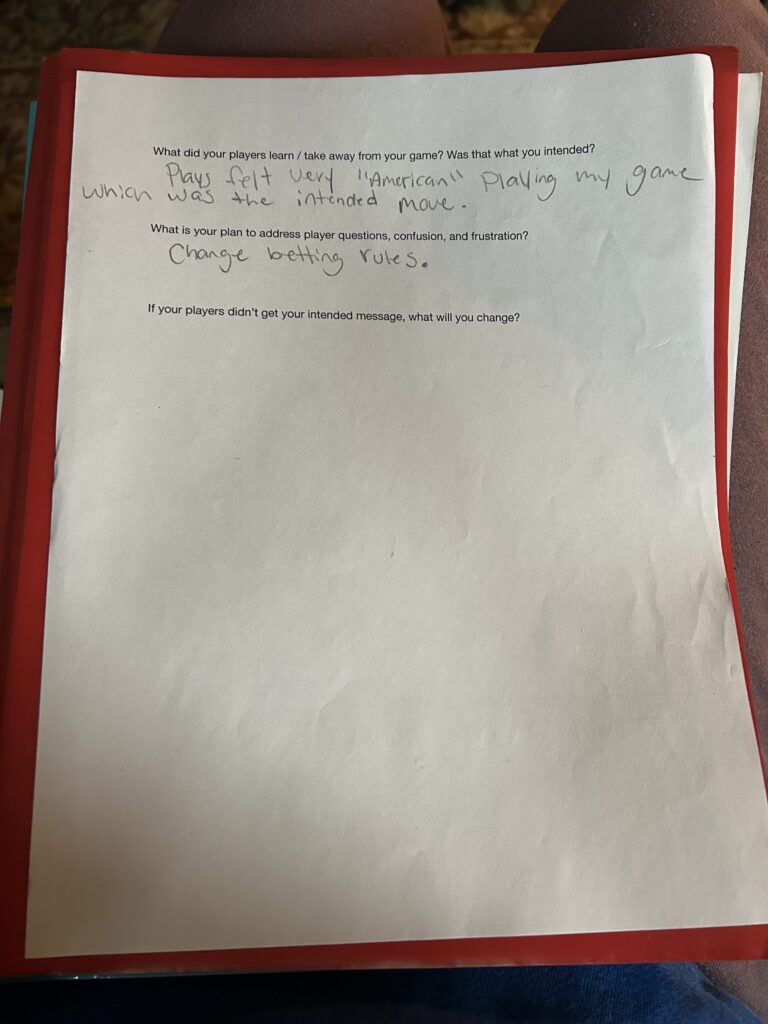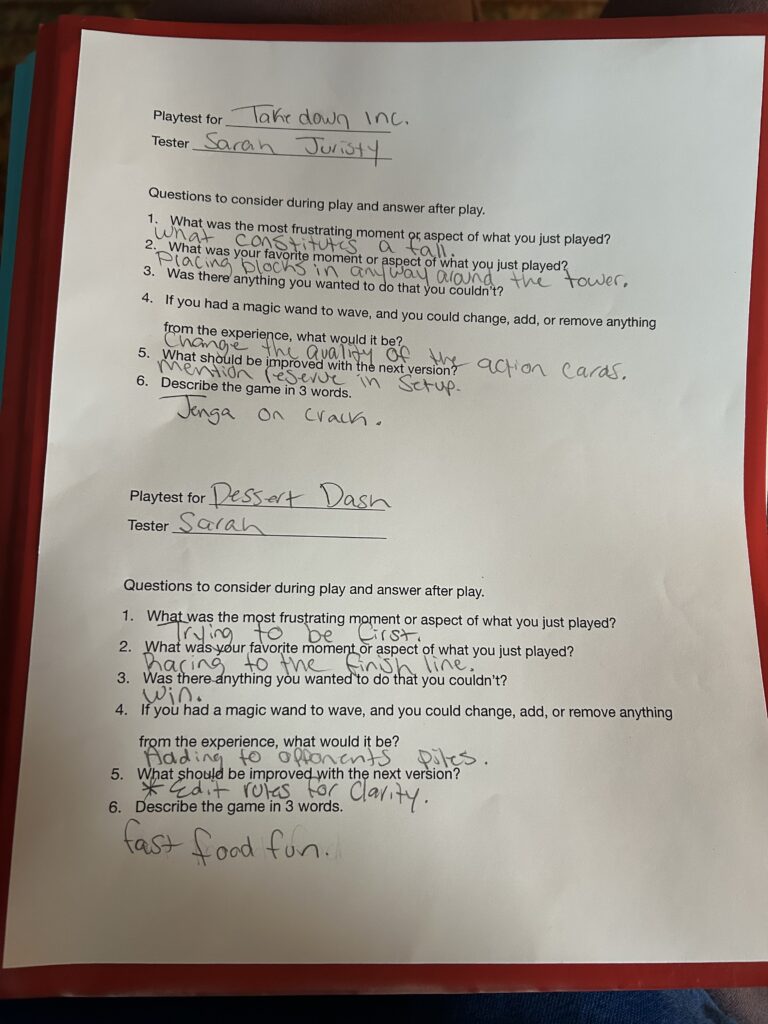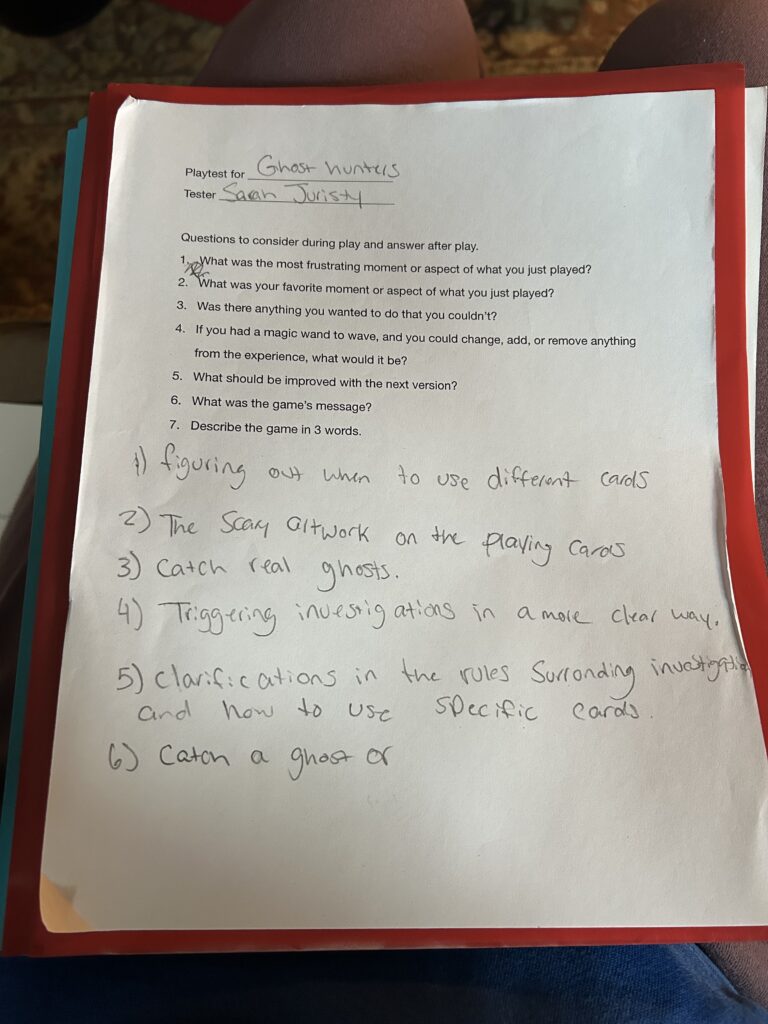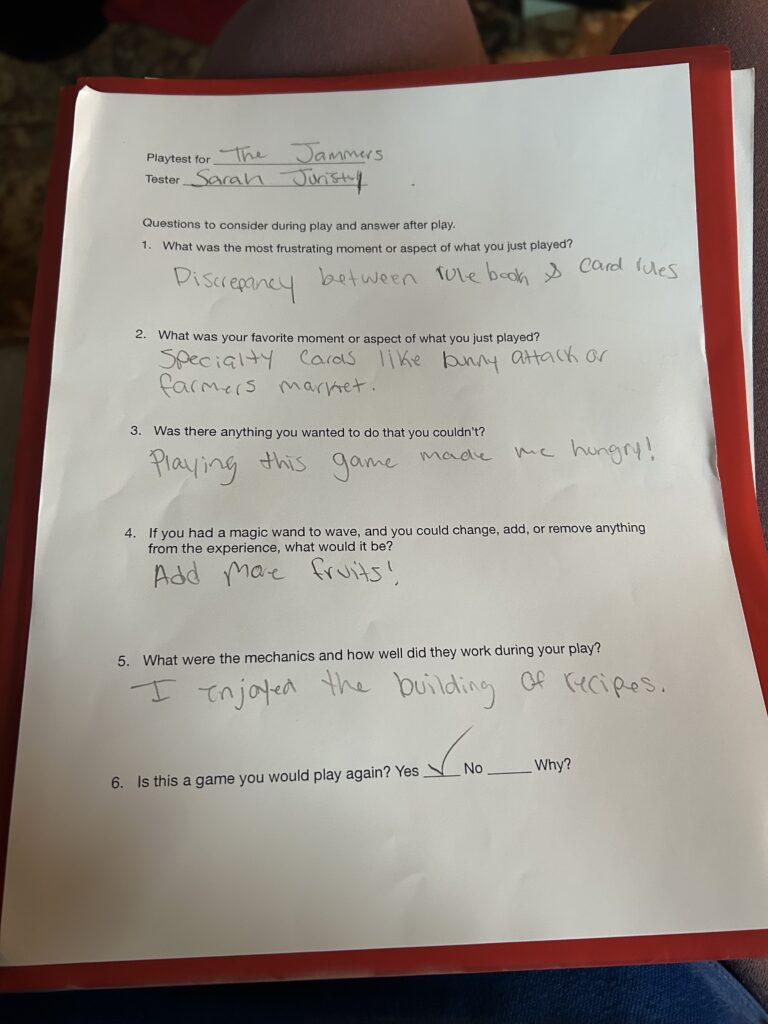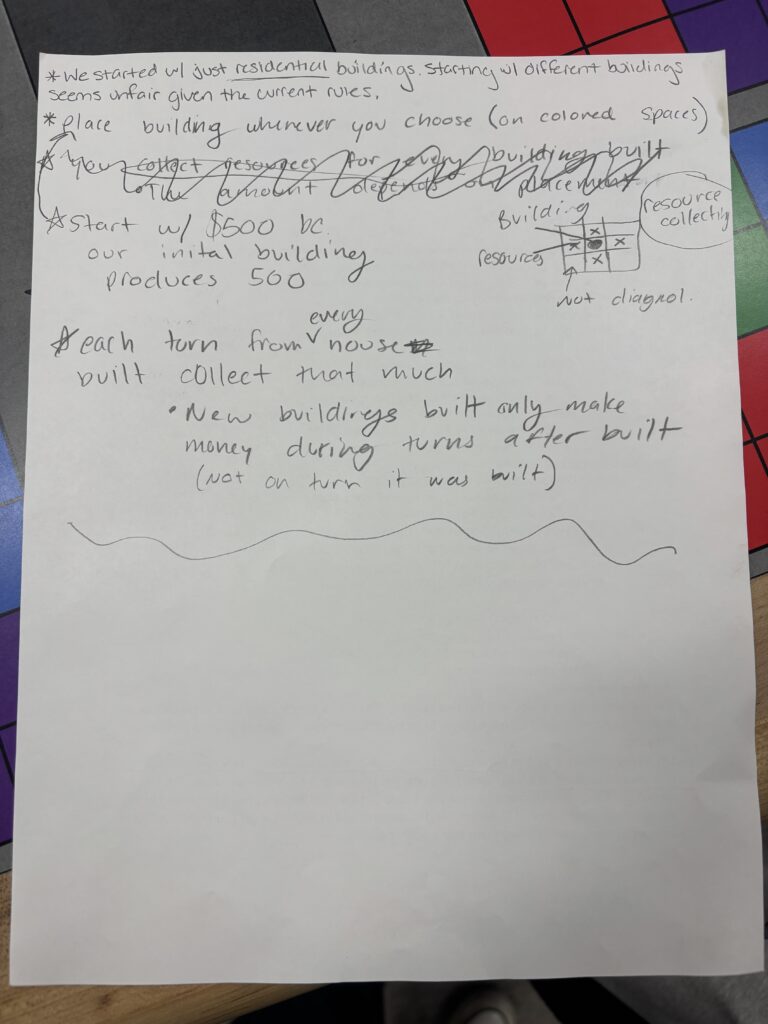Question Sets
Game Testing Documentation
Trick Or Treat Documentation
The Trial of the Taming Spires Documentation
Tale Weavers Documentation
Go Wish Documentation
Weeks 12-13 Question Sets
Question Set 1
- Working prototypes are intended for evaluation by playtesters and potential publishers, while display prototypes, with finished art and components, are intended for the eyes of distributors or chain buyers.
- Publishers want to see a clean, playable prototype. The game needs a clear set of rules so that playtesters can properly test the game. Without rules, the working prototype fails.
- According to Dale Yu, prototypes should look clean and well-made for a good first impression. Rules should be clear and correct, maybe even with diagrams and pictures to help first-time players understand how the game works. Components like cards, card sleeves, stickers, and paper are essential to make a clean game. Finally, he says if you want people to get excited about a game, send them home with a full, playable copy of it so they can play on their own time.
- Richard Levy’s first piece of advice is to be prepared. He also says to remember that information is power, meaning you should research the company you are publishing to and try and find other inventors to talk to about your game. He suggests selling yourself first and handling rejection well. Keeping your ego in control and having realistic expectations for a presentation. Finally, he suggests that inventors do multiple submissions of a game (revisions) and keep in mind how a trademark can impact their game being published.
- Pitching your game to small to mid-sized publishers in the hobby games industry is a suggested route to take.
- Publishers look for the fun factor, player interaction, immediacy of play, strategy, an interesting theme, an immersive experience, an interrelated theme, solid, innovative rules and mechanics, easily manufactured components, compatibility with other products, the correct target market, a good title, expansion potential, multi-language capability, easy demoing, and collectibility only if necessary.
- A good set of rules usually includes these subheaders: Overview, Components, Setup, Gameplay, Card types, Endgame and winning, Example of play/strategy hints/optional rules/game variants/glossary, and Credits.
Question Set 2
- The best game I made this semester, personally, was Headlampers. Headlampers is a board game in which the players take turns mining for ores by rolling dice and sabotaging their opponents with wild cards. The goals of the game are to end the game with the most points by collecting ores that will help you reach that goal, and attempting to lower the score of other players by drawing wild cards to sabotage opponents. In the event of a tie, a “pickaxe duel” must take place. Whoever rolls the higher number with the two dice is the true winner. The game is different each time, since tiles are detachable and randomized before each new round. Ore values are 1-5, 1 being the worst and 5 being the best. There are also bombs hidden within the board that have a value of -3. Wild cards occupy about 35%-40% of the board, and they prompt players to choose another to skip a turn, steal ores, or roll again, to name a few. Within playtesting, audiences liked the brevity and simplicity of the game. They liked how they didn’t need to use a ton of brain power, especially early in the morning.
Reactor 21 – Game Review
- I enjoyed Reactor 21 a lot. While the mechanics foil down to basic Blackjack, the mechanics added to the base game allow the concept of Blackjack to take an entirely new shape.
- Every decision needed a debate in Reactor 21 because the game is quite unforgiving. In our test, we had to make it slightly easier to account for the bad card luck.
- As someone who understood blackjack, it made understanding this game easier. However, Reactor 21 adds much more meta-game to the original blackjack formula, which took a bit to learn.
- The game, like blackjack, is entirely luck based. However, Reactor 21 gives you some breathing room to make mistakes and forces you to make otherwise bad decisions to risk reward.
- The stress of each decision and relief of a card that saved the game made the setting so much more real. It almost felt like we were balancing real nuclear reactors. The game does really well in balancing risk and allowing players to take risks to get a better result.
- A problem we ran into was not enough chances to recover in the event of too many “dead draws”. Even if you played perfectly, you could draw a max of 3 bad cards before you lose. This made the game really tough to win. We then expanded the limit of “instability” points to allow more breathing room.
- In my opinion. All the game needs is some theming and places to put points.
- Yes. Even for non-blackjack players, I think the game stands well enough on its own to be a complex game of risk and luck that requires decisions at every turn.
- In act one, players draw their first card and need to choose which reactor to add it to. In the second act, players have stabilized their reactors or have rising instability (depending on their luck). By the third act players need to make tough calls to balance their reactors.
- The game is entirely collaborative. A decision can greatly change the outcome of the game in the unforeseeable future, meaning every move counts. We were excited to see cards and devastated when we drew bad ones.
- The game has a nice theme about balancing nuclear reactors that are one wrong move away from destruction. I am not sure if any other game could highlight that stress as much as blackjack. The gameplay and setting blend seamlessly I’m my opinion.
- Hectic. Hard. Chance.
Takedown Inc. – Game Review
- The game was fun. I liked the methodical take on a pretty spontaneous game. The spinner forcing players to make decisions they might not make can put them in disadvantageous situations.
- Players took turns taking bricks from each others’ tower to reinforce their own, but had to make sure that they did not knock over their opponent’s tower.
- The game was quick to learn. The instructions build off of Jenga and were easy to understand.
- Some of the wild/action cards were not specified, and their ability to be played at any time interrupted the experience a bit. Also, no rules about taking bricks from the top were stated, which allowed players to avoid the dangers of the lower parts of the tower.
- I enjoyed the idea of the game. I believe that it was a nice blend of Twister and Jenga. I hope that, in a future version, colors and numbers can be used to further force players into tough situations.
- I wanted more ways to interact with my opponent. For example, an action card that forces players to take from their own tower can make the conflict stronger.
- I would add more rules or systems to the game to speed up the gameplay. I feel that the game takes a bit long to reach a point where players need to be worried about knocking their opponent’s tower down.
- Yes. It makes a fun party game that requires a bit more focus than normal Jenga.
- Players take their first bricks in the first act. In the second act, towers are losing their integrity as players are forced to make more dangerous decisions. Act three begins and ends a tower falls.
- Players are directly competing with each other, but do not want to knock their opponent’s towers over (which is a nice paradox).
- I believe the standout mechanic is the spinner and marked bricks. The spinner takes the agency of choice away from the player, forcing them to make plays they otherwise wouldn’t make. This makes the game more adaptive than normal Jenga.
- Stressful, Adaptable, Casual
Patchwork City – Game Review
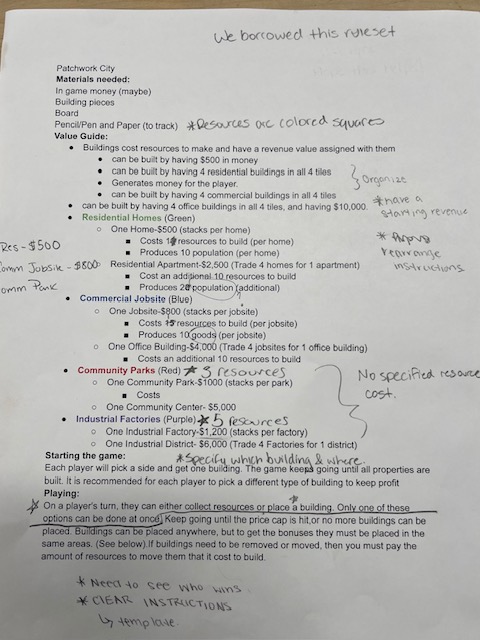
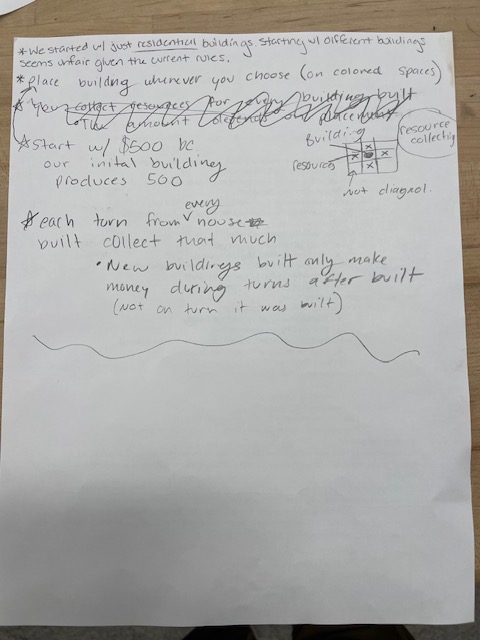
- The concept of the game was fun. I liked the idea of a complex resource management game where players need to weigh the pros and cons of buildings, and balance costs and resources.
- We as players did not interact much. Players were a bit isolated, silently competing with each other. What really mattered was what building somebody built at the right time.
- The game took a while to learn. Many of the mechanics were vague and unexplained, which made it hard to interpret and learn. We had to adapt many of the rules and procedures to have a playable game.
- The rules and instructions were very vague. The images above show revisions we made to make the game playable. Many of the mechanics of the game are not explained and leave players questioning, like money, population, goods, etc.
- I liked the macroeconomy that the game was going for. The large amount of resources to manage makes the game enjoyably complex. With some polish, it could really become a cool strategy game.
- I wanted to understand more.
- I would enforce a rule to match building colors with zone colors. I would also make resource acquisition a priority, as it wasn’t mentioned much and did not even affect the buildings in the late game.
- Yes, I would play the game when the rules are tightened and the scope is reduced.
- Act 1: Players build their first residential zone and acquire resources. Act 2: Players make strategic investment decisions in which property to build to compete with others. Act 3: Players rely on the revenue they generate to pass the money limit and win.
- Players are competitive in that they fight for the same resources and must be the first to reach a wealth goal.
- The game has a similar metaphor to Monopoly but players are much less adversaries than they are competitors. Players need to find the right strategy to generate enough wealth to win. A player’s immediate actions rarely affect other players.
- Players must plan their approach. Players must balance their resources. Players must be the first to the top.
“Chef Check” (ver. 1) – Rules
Created by: Harmony & Bryce
Players: 2-4
Age: 10+
Objective:
The goal of Chef Check is to be the first chef to reach the winning score by creating complete meal “runs” and earning points each round.
During each round, players race to get rid of all their cards by forming as many runs as possible, each run scoring valuable points. The round ends when one player plays or discards their last card, and everyone adds up their total points from completed meals.
Keep track of your points throughout the game.
Setup
- You need a score sheet and a pencil.
- Shuffle the Food Cards and deal all players 7 cards, and place the rest face down in the center as the Draw Pile.
- Turn the top card face up beside it — this is the Food Discard Pile.
- Create a separate space for the Sabotage Discard Pile, where used sabotage cards will go (they can’t be reused or picked up later)
Gameplay
- Any player can go first, and game continues clockwise
- To start your turn you must pick up a card from the discard pile or the draw pile.
- During your turn, you then have freedom to then lay down any meal runs you may have and/or use a sabotage card.
- When you use a Sabotage card, place it in the sabotage discard pile.
- Then to end your turn you have to discard one of your cards from your hand
- IF you picked up from the discard pile to BEGIN your turn, you CANNOT discard that card during the same turn.
- When discarding your card, place it on top of the previous card so that the previous card is no longer visible.
- IF the deck runs out of cards, reshuffle the food discard pile and take the top card and flip it over to begin the new discard pile and continue play.
Points
Players add up their points at the end of each round. These are the values of cards/runs:
- Chef Meals: 20pts
- Regular Meals: 10pts
IF you have cards remaining in your hand after a player has run out of cards, you subtract the point value of what is in your hand from your current points. Each card left in your hand is -5 points.
Winning
Once a player reaches 100 points after a few rounds of play, wins the game and the game ends.
Card Types:
There are 4 types of cards in Chef Check: Entree cards, Side cards, Drink cards, and Sabotage cards. Three cards of all food types make up a set:
Example: (Fillet Mignon [Entree], Rice [Side], Water [Drink]).
Entree cards are distinguished by the image of a plate with utensils, side dishes have an image of a bowl, and drinks have an image of a glass. Sabotage cards can be played once during a player’s turn, which can affect themselves or other players.
Chef Meals
Chef meals are special card sets that yield extra points when played. Instead of receiving 10 points for a set of 3 unrelated food items, completed chef meals yield 20. Cards in the same meal set are color coded below.
- High Class – Filet Mignon, Mashed Potato, Red Wine
- Pescitarian – Salmon, caesar salad, lemonade
- Meal prep – Roast Chicken, Rice, Water
- Cookout – BBQ Ribs, Mac and Cheese, Beer
- Red lobster – Lobster tail, Veggies, Dr. Pepper
Sabotage Cards: ( ! symbol on each card )
- Mice Attack: Your target has to get rid of ONE of their runs and put it in the discard pile.
- Kitchen Fire: You burnt one of your food items, discard a useless card from your hand.
- Food Swap: Swap one random card with another player.
Quads (ver. 3) – Rules
Introduction:
Quads is a fast-paced card game that blends the style of Poker with the mechanics of Spoons. Players pass cards between themselves, aiming to collect a winning hand to bet on. After a timed card-passing phase, players bet on their hands for the chance to win the pot.
What you will need:
- 3-6 players
- 1 deck of cards that includes Jokers
- A 30-second timer
- Betting chips in at least two different colors (or denominations), with enough for multiple rounds.
Game Setup
- Shuffle the deck of cards. Remember to include the jokers.
- Pass 1 card to each player. The player with the highest card becomes the “Passer”, who will cards from the deck during the Passing Phase. If two players tie, repeat this process between the players who tied until a tiebreaker is reached. If a joker is drawn, discard it and draw another card.
- The winner chooses the direction for passing cards: clockwise or counterclockwise. All players must pass cards in that chosen direction. (If you’d like, you can alter the direction of play after every round)
- Deal a number of chips depending on the difficulty you choose to play the game:
- Easy: Deal 5 green chips and 6 red chips to each player (21 points to start)
- Normal: Deal 4 green chips and 3 red chips to each player (15 points to start)
- Hard: Deal 2 green chips and 6 red chips to each player (12 points to start)
Green chips will be counted as 3 points, and red chips will be counted as 1. Extra chips should be made accessible if players run out of certain chips, and wish to exchange for chips of an equivalent value. If new to the game, play the game with a Normal level of chips.
Hand Rankings
This game borrows the hand ranking system from Poker, but removes some of the winning hands. Familiarize yourself with the ranking of hands below. Players with the highest ranking hand will claim the pot, or all chips in play. In the event of a tie, players must split the pot evenly, regardless of any extra cards (unless you are playing the Advanced Edition). When ready, start the passing phase.
Here are some examples of the hands you should be looking for.
- Four-of-a-Kind (Quads) – 4 cards of the same number (all suits): (4♠,4ç,4♦,4♣)
- Straight Flush – 4 sequential cards of the same suit: (2♠,3♠,4♠,5♠)
- Three-of-a-Kind – 3 cards of the same number (regardless of suit): (3♣,3♥,3♠,1♥)
- Two Pair – 2 pairs of cards with the same number (regardless of suit: (6♥,6♦,8♣,8♠)
- Pair – A pair of cards that share the same number (regardless of suit): (7♦,7♠,2♦,6♦)
Passing phase
- Shuffle the deck and deal 4 cards to each player. Place the remaining cards in an accessible place, this will become the draw pile. If a player receives a joker, reshuffle the joker back into the draw pile.
- When ready, the Passer will begin by drawing a card and discarding a card in their chosen direction. The player who received the card from the passer must collect the card and discard a card in the direction of the passer.
- When the last player in the cycle receives a card, they must discard a card in a pile adjacent to the draw pile. You should maintain a hand of 4 cards at all times.
- At any point during this process, players can “lock-in” their hand by placing their cards face-down and announcing it to the table. Locked-in players can no longer receive or discard cards. Players must pass around the locked-in player, and can draw if the previous passer locks-in.
- Continue this process until the first player locks in, or a Joker is drawn. If a Joker is drawn, the Passing Phase ends immediately and the betting phase begins.
- After the first player locks in a 30-second timer will begin. All other players must lock in their hands before the countdown ends to continue to the Betting Phase. When all but one player lock-in their hand, the passing phase ends immediately.
- Players who are holding more than 4 cards by the end of the Passing Phase are disqualified from the betting phase. Move quickly.
Betting Phase
Once the Passing Phase ends, all players (that are not disqualified) enter the betting phase. Given their current hand, players can choose to:
- Bet High – Place one green chip worth 3 points.
- Bet Low – Place one red chip worth 1 point
- Fold – Place your hand face down and disqualify yourself, making no bet.
The player who is locked-in first must start the betting phase, and the order of betting will follow the order of passing. After all decisions have been made, players enter the Reveal Phase.
Reveal Phase
Once the Betting Phase ends, all betting players must reveal their hand to the table. The player with the highest ranking hand will take the entire pot. If two players tie, and no other hand outranks them, they must split the pot as evenly as possible (Exchange chips if needed). If all players but one fold, the winner can take the pot “uncontested” and does not need to reveal their cards (It would make the game funnier if they did though). Players who run out of chips are eliminated from the game unless house rules state otherwise.
Collect the cards, shuffle the deck, then restart the Passing Phase. Continue until a Win Condition is reached.
Win conditions
Players can decide a winner using points, rounds, disqualification, or some mixture of the 3. Here’s some standard examples to provide a framework, but feel free to create your own:
- After 5/10/15 rounds, count the value of the chips. The player with the highest number of points wins. To start, play between 5-8 rounds and choose the winner based on chips.
- Given the number of points each player starts with, set a winning number of points players must reach to win.
- The last player to be disqualified wins the game.
Advanced Edition (Optional Rules): Read if you’ve played Quads enough
If you’ve played enough Quads to understand the game, and want more complexity/challenge, feel free to add some bonus rules:
- No betting limit: Players can bet as many or little points as desired (be sure to adjust the points/starting chips to account for this)
- Add more winning hands to the game
- Straight – Any hand of cards that progress in numerical order, regardless of suit
- High Card – If two players tie with the same hand rank, the player with the highest unmatched card wins the pot.
- Add 1-2 more decks to the original to increase complexity
- Expand the hand limit from 4 to 5
- Play with more players (alter time and decks for extra players)
Chef Check rules- group proj.
Chef Check
Created by: Harmony & Bryce
Players: 2-4
Age: 10+
Objective:
The goal of Chef Check is to be the first chef to reach the winning score by creating complete meal “runs” and earning points each round.
During each round, players race to get rid of all their cards by forming as many runs as possible, each run scoring valuable points. The round ends when one player plays or discards their last card, and everyone adds up their total points from completed meals.
Keep track of your points throughout the game.
Setup
- You need a score sheet and a pencil.
- Shuffle the Food Cards and deal all players 7 cards, and place the rest face down in the center as the Draw Pile.
- Turn the top card face up beside it — this is the Food Discard Pile.
- Create a separate space for the Sabotage Discard Pile, where used sabotage cards will go (they can’t be reused or picked up later)
Gameplay
- Any player can go first, and game continues clockwise
- To start your turn you must pick up a card from the discard pile or the draw pile.
- During your turn, you then have freedom to then lay down any meal runs you may have and/or use a sabotage card.
- When you use a Sabotage card, place it in the sabotage discard pile.
- Then to end your turn you have to discard one of your cards from your hand
- IF you picked up from the discard pile to BEGIN your turn, you CANNOT discard that card during the same turn.
- When discarding your card, place it on top of the previous card so that the previous card is no longer visible.
- IF the deck runs out of cards, reshuffle the food discard pile and take the top card and flip it over to begin the new discard pile and continue play.
Points
Players add up their points at the end of each round. These are the values of cards/runs:
- Chef Meals: 20pts
- Regular Meals: 10pts
IF you have cards remaining in your hand after a player has run out of cards, you subtract the point value of what is in your hand from your current points. Each card left in your hand is -5 points.
Winning
Once a player reaches 100 points after a few rounds of play, wins the game and the game ends.
Card Types:
There are 4 types of cards in Chef Check: Entree cards, Side cards, Drink cards, and Sabotage cards. Three cards of all food types make up a set:
Example: (Fillet Mignon [Entree], Rice [Side], Water [Drink]).
Entree cards are distinguished by the image of a plate with utensils, side dishes have an image of a bowl, and drinks have an image of a glass. Sabotage cards can be played once during a player’s turn, which can affect themselves or other players.
Chef Meals
Chef meals are special card sets that yield extra points when played. Instead of receiving 10 points for a set of 3 unrelated food items, completed chef meals yield 20. Cards in the same meal set are color coded below.
- High Class – Filet Mignon, Mashed Potato, Red Wine
- Pescitarian – Salmon, caesar salad, lemonade
- Meal prep – Roast Chicken, Rice, Water
- Cookout – BBQ Ribs, Mac and Cheese, Beer
- Red lobster – Lobster tail, Veggies, Dr. Pepper
Sabotage Cards: ( ! symbol on each card )
- Mice Attack: Your target has to get rid of ONE of their runs and put it in the discard pile.
- Kitchen Fire: You burnt one of your food items, discard a useless card from your hand.
- Food Swap: Swap one random card with another player.



